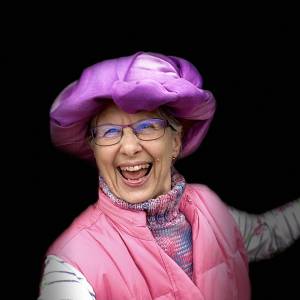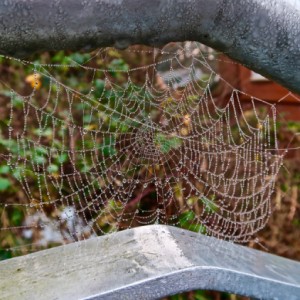MY STREET CHALLENGE - YERSIN COURT
I am almost at the end of my self-imposed Street Challenge so this week I wanted to find an unusual street name beginning with the letter “Y” and I think I’ve managed to do that!
Most of the Blips for my Street Challenge have been about Swindon “in the past”, but this penultimate one is for a more modern era. Whilst there is nothing wrong with modern houses, they do look pretty much the same, so instead of giving facts and figures about the actual houses, I decided that as well as taking photographs, I would do something different and find out the origins of the important people in history after whom the streets were named. I must say that I have learned a lot whilst researching this and hope you enjoy reading my journal today.
When I looked online to find a street in Swindon beginning with the letter “Y” I was interested to find that there was a place called Yersin Court. Never having heard the name before, I started doing some more research. Yersin Court and the streets around were all built on the site of the old Princess Margaret Hospital, which was opened in 1966, closed at the end of 2002 and has now been demolished, so I can understand the reasoning behind the naming of this particular Court and the other streets in the vicinity, which are obviously named to reflect the site’s history and this has been confirmed by Liz, the kind and helpful lady in our local Council office.
It was a very foggy morning when we set out and not having been to the area previously, we found it quite difficult finding the various streets. In fact, as most new housing estates the planners do not seem to have taken account of the fact that most people have cars and it was quite difficult negotiating the various twists and turns in the narrow roads, hence the reason for having bollards on various properties, to stop cars getting too close to the houses.
Yersin Court consisting mainly of apartments, is named after Alexandre Emile Jean Yersin who was born in 1863 in Switzerland but later took French nationality. A physician and bacteriologist, he is remembered as the discoverer of the bacillus responsible for the bubonic plague or pest, which was later named Yersinia pestis in his honour. Two years after he graduated, he left Paris for French Indochina where he was the first European to explore and map the central highlands of Vietnam. Whilst in Vietnam, Yersin established a Pasteur Institute in the coastal village of Nha Trang where he lived until he died in 1943. In Vietnam, as in France, the name of Yersin continues to be venerated.
Our younger son presently lives in Vietnam so I asked him if he had heard of Yersin – he said that there was a Yersin Street in Ho Chi Minh city and from a Google search, I found there is also one in Hanoi and Nha Trang.
Yersin Court is within a larger area named Celsus Grove, consisting of apartments and other houses and is named after the Roman writer, Aulus Cornelius Celsus, (25BC-50AD). He lived in Rome at the time of the Emperior Tiberius and was probably a member of Rome’s leading circle. Although he was not a practising physician, it is thought he wrote one of the most important Roman texts on medicine. He was interested in preventative medicine as much as in cures and his medical texts recommended a healthy lifestyle with a balanced diet, regular exercise and good personal hygiene – I guess we would do well to read some of his work today. The only surviving works of his medical encyclopedias were rediscovered in the Vatican Library in about 1480.
The main road into this estate is from Curie Avenue, named after the Curies and which consists again of apartments and houses. Marie Skłodowska, born in Warsaw in 1867, was a physicist and chemist and one of the most famous scientists of her time. In 1891 when she went to Paris to study physics and mathematics at the Sorbonne, she met Pierre Curie, professor of the School of Physics and they were married in 1895. Together with her husband she was awarded the Nobel Prize in 1903. Pierre was knocked down and killed by a carriage in 1906 and following his death, Marie took over his teaching post, becoming the first woman to teach at the Sorbonne and devoted herself to continuing the work that they had begun together. In 1911 she won a second Nobel Prize for Chemistry. She died on 4 July 1934 from leukaemia, caused by exposure to high-energy radiation during the time of her research.
After negotiating Celsus Court, we arrived in Pasteur Drive, still with many cars parked on both sides, but there is a very pleasant play area in the centre, where we noticed a couple doing exercises and running round the circular play park with many of the apartments looking down on this area. This is named after Louis Pasteur, a chemist and microbiologist, born in France in 1822. He developed the first vaccines for rabies and anthrax and his discoveries led to an understanding of microbes and diseases that has helped to save millions of lives, and also led to the development of antiseptics that changed healthcare forever. He is most remembered by the Pasteur Institute, which he established in 1887 and today this Institute is one of the world leaders in battling infectious diseases. His name is remembered every day with the invention of the technique of treating milk and wine to stop bacterial contamination, named “pasteurisation” in his honour. Pasteur died in 1895 as the result of a stroke and is buried in the Cathedral of Notre Dame in Paris.
Off Pasteur Drive is a small pedestrianised street named Tuke Walk – consisting of apartments and town houses and named after a medical man, William Tuke, born in York, England in 1732. He went into the family tea and coffee making business, which later became part of the Twinings Tea Company, and as a philanthropist was noted for his work in mental health. He was known for his strict self-discipline and was also a firm believer in the Quaker faith, actively supporting the group and employing many of their principles in his work. He pioneered the use of moral treatment, a new humane method of treating mental illness with gentleness and respect, focusing on allowing patients to live in a community, partake in daily activities and not be subjected to the brutality of the commonplace asylum, all of which were very rare in the treatment of lunatics at that time. He died in 1822, aged 90.
Seacole Crescent, a continuation of Pasteur Drive, and once again consisting of a mix of apartments and houses, is named after Mary Jane Seacole, born in Kingston, Jamaica in 1805 as Mary Jane Grant. She learned her nursing skills from her Jamaican mother, who kept a boarding house for wounded soldiers. In 1836, Mary married Edwin Horatio Seacole, one of her mother’s guests but sadly the marriage was short-lived as he died in 1844. Mary nursed cases of yellow fever and cholera in Jamaica and as her fame as a medical practitioner grew she was soon carrying out operations on people suffering from knife and gunshot wounds. In 1854 she funded her own trip to the Crimea where she established the British Hotel near Balaclava to provide comfortable quarters for sick and convalescent officers. She also visited the battlefield, sometimes under fire, to nurse the wounded, and became known as “Mother Seacole” where it was said her reputation rivalled that of Florence Nightingale. She died in 1881.
I know there are two photographs for Seacole Crescent, but as it is Christmas, I thought the one mentioning "Mistletoe Court" was quite appropriate.
Galen View is well named as it does indeed have a wonderful view over the countryside, and is named after Claudius Galen who was born in Greece in 131 AD and died in 200 AD. He studied medicine in Egypt and became the most celebrated physician in the Roman Empire. He put great emphasis on clinical observation – examining a patient very thoroughly and noting their symptoms. Galen also accepted the view that disease was the result of an imbalance between blood, phlegm, yellow bile and blood bile. He also believed in the healing power of nature and in the use of opposites – if a man appeared to have a fever, he treated it with something cold; if a man appeared to have a cold, he would be treated with heat. Those who were weak were given hard physical exercises to do to build up their muscles and many who had breathing problems due to a weak chest were given singing exercises.
You may be wondering what my “claim to fame” is for this area – well, I have been racking my brain to think of something interesting – I was an in-patient at the Princess Margaret Hospital at least four times in my life – for three knee operations and to have wisdom teeth removed (no rude comments, please) but thought you wouldn’t want to see photographs of either my knees or my gums, so my only other claim to fame for this area is that both our sons were born in the Maternity Unit at the said hospital – one in 1971 and the other in 1974. I thought they would probably not be very happy if I put a “baby” photograph of either of them, so here is a photograph I’m very fond of, taken in the mid 1970s, wearing jumpers hand-knitted by me and Mr. HCB’s mother.
In this trouble world of ours, I would like to think that this quote by Louis Pasteur will soon prove to be true.
“I am utterly convinced that
science and peace will triumph
over ignorance and war,
that nations will eventually unite
not to destroy but to edify,
and that the future will belong
to those who have done the most
for the sake of suffering humanity.”
Louis Pasteur 1822-1895
P.S. My extra photograph was taken when I walked up some steps to take a photograph of Pasteur Drive and saw this beautiful spider's web sparkling with dew drops. When I came down the steps, I saw our daughter-in-law's sister, who happens to live in the area, out running - she was well into her stride, so said she would "catch me later" - I have to admit that she would catch me easier than I would catch her!


Comments
Sign in or get an account to comment.


